Opening a personal checking account is a fundamental step in managing your finances. Whether you are opening your first account or switching to a new bank, choosing the right institution is crucial. Here’s a comprehensive guide to help you navigate where to start a personal checking account and what factors to consider.
Types of Financial Institutions
Traditional Banks
Traditional banks, such as Chase, Bank of America, and Wells Fargo, offer a wide range of financial services, including personal checking accounts. They have extensive branch networks and ATMs, providing convenient access to your funds. Traditional banks also offer online and mobile banking services, making it easy to manage your account on the go. However, they may charge higher fees compared to other institutions.
Credit Unions
Credit unions are member-owned financial cooperatives that often provide better rates and lower fees than traditional banks. Examples include Navy Federal Credit Union and Alliant Credit Union. Credit unions typically offer personalized customer service and may provide more favorable terms for loans and credit cards. However, they may have fewer branches and ATMs compared to large banks.
Online Banks
Online banks, such as Ally Bank, Discover Bank, and Chime, operate entirely online without physical branches. They often offer higher interest rates on checking accounts and lower fees due to reduced overhead costs. Online banks provide robust digital banking services, including mobile apps and online bill pay. The main drawback is the lack of in-person services, which may be a disadvantage for those who prefer face-to-face interactions.
Community Banks
Community banks, like local and regional banks, focus on serving the needs of their local communities. They offer personalized service and may have lower fees and better rates than larger banks. Community banks often support local economic growth by providing loans to small businesses and individuals within the community. However, they may have limited branch networks and fewer ATMs.
Factors to Consider
Fees and Minimum Balance Requirements
When choosing where to open a checking account, consider the fees and minimum balance requirements. Look for accounts with low or no monthly maintenance fees, and be aware of other potential charges such as ATM fees, overdraft fees, and foreign transaction fees. Some banks waive monthly fees if you meet certain requirements, such as maintaining a minimum balance or setting up direct deposit.
Interest Rates and Rewards
While most checking accounts do not offer high-interest rates, some institutions provide interest-bearing checking accounts or rewards programs. Online banks and credit unions are more likely to offer competitive interest rates. Additionally, some banks offer cash back or rewards points for using your debit card, which can add value to your account.
Accessibility and Convenience
Consider the accessibility and convenience of the bank’s services. If you prefer in-person banking, choose an institution with a strong branch and ATM network in your area. For those who prefer digital banking, look for banks with highly rated mobile apps and online banking platforms. Ensure that the bank offers features such as mobile check deposit, online bill pay, and real-time transaction alerts.
Customer Service
Customer service is a crucial factor when selecting a bank. Read reviews and ask for recommendations to gauge the quality of customer service at various institutions. Some banks offer 24/7 customer support via phone, chat, or email, which can be beneficial if you encounter issues outside of regular business hours.
Security and Fraud Protection
Ensure that the bank you choose has robust security measures to protect your personal and financial information. Look for features such as encryption, multi-factor authentication, and real-time fraud monitoring. Additionally, consider whether the bank offers zero-liability protection for unauthorized transactions on your debit card.
Steps to Open a Checking Account
Research and Compare Options
Start by researching and comparing different banks and their checking account offerings. Consider the factors mentioned above and create a shortlist of institutions that meet your needs.
Gather Required Documentation
To open a checking account, you will need to provide certain documentation. Typically, this includes a government-issued photo ID (such as a driver’s license or passport), your Social Security number, and proof of address (such as a utility bill or lease agreement). Some banks may also require an initial deposit to fund the account.
Apply Online or In-Person
Most banks allow you to apply for a checking account online or in person. Online applications are convenient and can be completed from the comfort of your home. If you prefer in-person interactions, visit a local branch to complete the application process. During the application, you will need to provide the required documentation and agree to the bank’s terms and conditions.
Fund Your Account
Once your application is approved, you will need to fund your new checking account. This can typically be done through an electronic transfer from another bank account, a check deposit, or cash deposit at a branch or ATM. Some banks may require an initial deposit of a specific amount to activate your account.
Set Up Online and Mobile Banking
After funding your account, set up online and mobile banking to manage your finances conveniently. Download the bank’s mobile app and register for online banking. This will allow you to check your balance, transfer funds, pay bills, and monitor transactions from your computer or mobile device.
Activate Your Debit Card
Your new checking account will come with a debit card, which you will need to activate. Follow the instructions provided by your bank to activate the card, which usually involves calling a specific phone number or using the bank’s mobile app. Once activated, you can use your debit card for purchases and ATM withdrawals.



